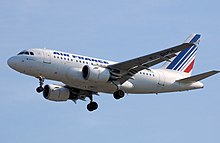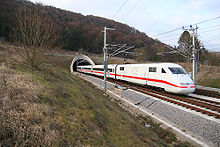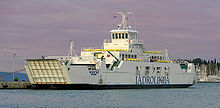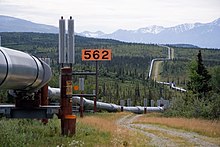Mode of transport
| Part of a series on |
| Transport |
|---|
| Modes |
| Topics |
|
|
Amode of transportis a method or way of travelling, or of transporting people or cargo.[1]The different modes of transport includeair,water,andland transport,which includesrails or railways,roadandoff-road transport.Other modes of transport also exist, includingpipelines,cable transport,andspace transport.Human-powered transportandanimal-powered transportare sometimes regarded as distinct modes, but they may lie in other categories such as land or water transport.
In general,transportationrefers to the moving of people, animals, and other goods from one place to another, andmeans of transportrefers to the transport facilities used to carry people or cargo according to the chosen mode. Examples of the means of transport include automobile, airplane, ship, truck, and train. Each mode of transport has a fundamentally different set of technological solutions. Each mode has its owninfrastructure,vehicles,transport operators andoperations.
Animal-powered[edit]
Animal-powered transport is the use ofworking animalsfor the transport of people and/or goods. Humans may use some of the animals directly, use them aspack animalsfor carrying goods, or harness them, alone or inteams,to pull watercraft,sleds,or wheeledvehicles.
Air[edit]

Afixed-wing aircraft,typicallyairplane,is a heavier-than-air flying vehicle, in which the special geometry of the wings generates lift and then lifts the whole vehicle. Fixed-wing aircraft range from small trainers and recreational aircraft to largeairlinersand militarycargo aircraft.For short distances or in places without runways,helicopterscan be operable.[2](Other types of aircraft, likeautogyrosandairships,are not a significant portion of air transport.)
Air transport is one of the fastest method of transport, Commercial jets reach speeds of up to 955 kilometres per hour (593 mph) and a considerably higher ground speed if there is ajet streamtailwind, while piston-powered general aviation aircraft may reach up to 555 kilometres per hour (345 mph) or more. This celerity comes with higher cost and energy use,[3]andaviation's impacts to the environmentand particularly the global climate require consideration when comparing modes of transportation.[4]TheIntergovernmental Panel on Climate Change(IPCC) estimates a commercial jet's flight to have some 2-4 times the effect on the climate than if the same CO2emissions were made at ground level, because of different atmospheric chemistry andradiative forcingeffects at the higher altitude.[5]U.S. airlines alone burned about 16.2 billion gallons of fuel during the twelve months between October 2013 and September 2014.[6]WHO estimates that globally as many as 500,000 people at a time are on planes.[3]The global trend has been for increasing numbers of people to travel by air, and individually to do so with increasing frequency and over longer distances, a dilemma that has the attention of climate scientists and other researchers,[7][8][9]the press,[10][11]and the World Wide Web.[12]The issue of impacts from frequent travel, particularly by air because of the long distances that are easily covered in one or a few days, is calledhypermobilityand has been a topic of research and governmental concern for many years.
Human powered[edit]

Human powered transport, a form ofsustainable transportation,is the transport of people and/or goods usinghumanmuscle-power, in the form ofwalking,runningandswimming.Moderntechnologyhas allowedmachinesto enhance human power. Human-powered transport remains popular for reasons of cost-saving,leisure,physical exercise,andenvironmentalism;it is sometimes the only type available, especially in underdeveloped or inaccessible regions.
Although humans are able to walk without infrastructure, the transport can be enhanced through the use of roads, especially when using the human power with vehicles, such asbicyclesandinline skates.Human-powered vehicles have also been developed for difficult environments, such as snow and water, bywatercraft rowingandskiing;even the air can be entered withhuman-powered aircraft.
Land[edit]
Land transport covers all land-based transportation systems that provide for the movement of people, goods and services. Land transport plays a vital role in linking communities to each other. Land transport is a key factor inurban planning.It consists of 2 kinds, rail and road.
Rail[edit]

Rail transportis a means of conveyance of passengers and goods by way of wheeled vehicles running onrail track,known as a railway or railroad. The rails are anchored perpendicular to railroad trainconsistsof one or more connected vehicles that run on the rails. Propulsion is commonly provided by alocomotive,that hauls a series of unpowered cars, that can carry passengers or freight. The locomotive can be powered bysteam,dieselor byelectricitysupplied bytrackside systems.Alternatively, some or all the cars can be powered, known as amultiple unit.Also, a train can be powered byhorses,cables,gravity,pneumaticsandgas turbines.Railed vehicles move with much less friction than rubber tires on paved roads, making trains moreenergy efficient,though not as efficient as ships.
Intercity trainsare long-haul services connecting cities;[13]modernhigh-speed railis capable of speeds up to 430 km/h (270 mph), but this requires a specially built track.Regionalandcommutertrains feed cities from suburbs and surrounding areas, while intra-urban transport is performed by high-capacitytramwaysandrapid transits,often making up the backbone of a city'spublic transport.Freight trains traditionally usedbox cars,requiring manual loading and unloading of thecargo.Since the 1960s, container trains have become the dominant solution for general freight, while large quantities of bulk are transported by dedicated trains.
Road[edit]



A road is an identifiable route of travel, usually surfaced with gravel, asphalt or concrete, and supporting land passage by foot or by a number of vehicles.
The most common road vehicle in the developed world is theautomobile,a wheeled passenger vehicle that carries its ownmotor.As of 2002, there were 591 million automobiles worldwide.[citation needed]Other users of roads includemotorcycles,buses,trucks,bicyclesandpedestrians,and special provisions are sometimes made for each of these. For example,bus lanesgive priority for public transport, andcycle lanesprovide special areas of road for bicycles to use.
Automobiles offer high flexibility, but are deemed with high energy and area use, and the main source ofnoiseandair pollutionin cities; buses allow for more efficient travel at the cost of reduced flexibility.[14]Road transport by truck is often the initial and final stage of freight transport.
Water[edit]

Water transport is the process of transport that awatercraft,such as a bart, ship or sailboat, makes over a body of water, such as a sea, ocean, lake, canal, or river. If a boat or other vessel can successfully pass through a waterway it is known as a navigable waterway. The need for buoyancy unites watercraft, and makes thehulla dominant aspect of its construction, maintenance and appearance. When a boat is floating on the water the hull of the boat is pushing aside water where the hull now is, this is known as displacement.
In the 1800s, the firststeamboatswere developed, using asteam engineto drive apaddle wheelor propeller to move the ship. The steam was produced using wood or coal. Now, most ships have an engine using a slightly refined type of petroleum calledbunker fuel.Some ships, such assubmarines,use nuclear power to produce the steam. Recreational or educational craft still use wind power, while some smaller craft useinternal combustion enginesto drive one or more propellers, or in the case of jet boats, an inboard water jet. In shallow draft areas,hovercraftare propelled by large pusher-prop fans.
Although slow, modern sea transport is a highly effective method of transporting large quantities of non-perishable goods. Commercial vessels, nearly 35,000 in number, carried 7.4 billion tons of cargo in 2007.[15]Transport by water is significantly less costly than air transport for transcontinentalshipping;[16]short sea shippingand ferries remain viable in coastal areas.[17][18]
Other modes[edit]
Micromobilityis the collective name for small electric powered vehicles.

Pipeline transportsends goods through a pipe, most commonly liquid and gases are sent, butpneumatic tubescan also send solid capsules using compressed air. For example, liquids/gases, any chemically stable liquid or gas can be sent through a pipeline. Short-distance systems exist for sewage, slurry water and beer, while long-distance networks are used for petroleum and natural gas.
Cable transportis a broad mode where vehicles are pulled by cables instead of an internal power source. It is most commonly used at steep gradient. Typical solutions includeaerial tramway,elevators,escalatorandski lifts;some of these are also categorized asconveyortransport.
Space transportis transport out of Earth's atmosphere into outer space by means of aspacecraft.While large amounts of research have gone into technology, it is rarely used except to put satellites into orbit, and conduct scientific experiments. However, people have landed on the moon, and probes have been sent to all the planets of the Solar System.
Unmanned aerial vehicletransport (drone transport) is being used for medicine transportation in least developed countries with inadequate infrastructure by an American-based start-up Zipline.[19]Amazonand other transportation companies are currently testing the use of unmanned aerial vehicles in parcel delivery. This method will allow short-range small-parcel delivery in a short time frame.
Components of a mode of transport[edit]
A transport mode is a combination of the following:
- Transportation infrastructure:thoroughfares,networks,hubs(stations,bus terminals,airport terminals), etc.
- Vehiclesandcontainers:motor vehicles,automobiles,motorcycles,trucks,wagons,trains,ships,andaircraft
- A stationary or mobile workforce
- Propulsion system and power supply (traction)
- Operations:driving, management, traffic signals,railway signalling,air traffic control,etc.
Comparison of the transport mode by distance travelled[edit]
This section needs to beupdated.(November 2020) |
Worldwide, the most widely used modes for passenger transport are the Automobile (16,000 bn passenger km), followed by Buses (7,000), Air (2,800), Railways (1,900), and Urban Rail (250).[20]
The most widely used modes for freight transport are Sea (40,000 bn ton km), followed by Road (7,000), Railways (6,500), Oil pipelines (2,000) and Inland Navigation (1,500).[20]
| EU 15 [clarification needed] |
US | Japan | World | |
|---|---|---|---|---|
| GDP (PPP) per capita (€) (for comparison) |
19,000 | 28,600 | 26,000 | 7,500 |
| Private car | 10,100 | 33,200 | 6,200 | 2,700 |
| Bus/coach | 1,050 | 150 | 740 | 1,200 |
| Railway | 750 | 78 | 2,900 | 32 |
| Air (domestic except World) | 860 | 2,800 | 580 | 480 |
See also[edit]
References[edit]
- ^"mode of transport".Collins Dictionary.Retrieved14 July2023.
- ^Cooperet al.,1998: 281
- ^abSwine flu prompts EU warning on travel to the US.The Guardian.April 28, 2009.
- ^The Future of Air Transport White Paper(2009), HMSO"The aviation industry is encouraged to take account of, and where appropriate reduce, its contribution to global warming...The impact of aviation on climate change is increased over that of direct CO2emissions alone by some of the other emissions released and their specific effects at altitude ".
- ^IPCC,Aviation and the Global Atmosphere: A Special Report of the Intergovernmental Panel on Climate Change(2000), Cambridge University Press
- ^Why airfare keeps rising despite lower oil pricesArchived2014-11-20 at theWayback Machine,by Scott Mayerowitz, Assoc. Press Airlines Writer. Houston Chron., November 17, 2014.
- ^Cohen, S.; Higham, J.; Cavaliere, C. (2011)."Binge flying: Behavioural addiction and climate change"(PDF).Annals of Tourism Research.38(3): 1070–1089.doi:10.1016/j.annals.2011.01.013.
- ^Cohen, S. A.; Higham, J. E. (2011)."Eyes wide shut? UK consumer perceptions on aviation climate impacts and travel decisions to New Zealand"(PDF).Current Issues in Tourism.14(4): 323–335.doi:10.1080/13683501003653387.S2CID154791383.
- ^Anderson, K.; Bows, A. (2008). "Reframing the climate change challenge in light of post-2000 emission trends".Philosophical Transactions of the Royal Society A: Mathematical, Physical and Engineering Sciences.366(1882): 3863–3882.Bibcode:2008RSPTA.366.3863A.doi:10.1098/rsta.2008.0138.PMID18757271.S2CID8242255.
- ^Jenkins S. (2009).Hypermobility is now the opium of the people, an obsession that wrecks communities and planet.The Guardian. 22 Dec. 2009.
- ^Rosenthal E. (2010).Can we kick our addiction to flying?Guardian, UK. 24 May 2010.
- ^Internet search fortravel addiction.
- ^Cooperet al.,1998: 279
- ^Cooperet al.,1998: 278
- ^United Nations Conference on Trade and Development2007, p.xand p. 32.
- ^Stopford, 1997: 4–6
- ^Stopford, 1997: 8–9
- ^Cooperet al.,1998: 280
- ^"Zipline - Lifesaving Deliveries by Drone".flyzipline.Retrieved2019-04-11.
- ^abc"Archived copy"(PDF).Archived fromthe original(PDF)on 2010-10-11.Retrieved2006-05-26.
{{cite web}}:CS1 maint: archived copy as title (link)
